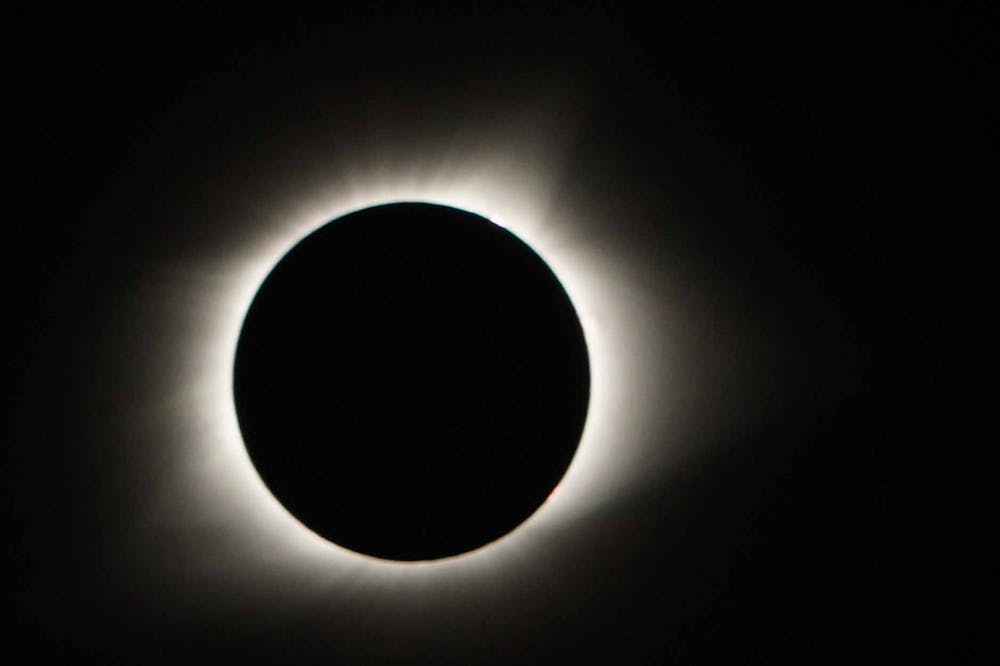The total eclipse on April 8 is a once-in-a-lifetime event for Oxford. I experienced the 2017 total eclipse in southern Illinois, and it was so memorable that a photo I took still serves as my desktop screensaver, seven years later.
The eclipse starts here on Monday, April 8, at approximately 1:53 p.m. Totality in Oxford starts at 3:08:23 p.m. and lasts for 2 minutes and 51 seconds. I’d like to share some thoughts specific to enjoyment of the eclipse here in Oxford.
My first tip is to scout out a couple of days in advance for a good place to watch the eclipse. The sun will be located essentially in the same location on April 7 as it is on April 8.
The period prior to totality is just as breathtaking as the actual 3 minutes of totality itself. Try to be in position no later than 1:45 p.m. The reason is that the moon will start to move across the sun starting at 1:53, forming a constantly decreasing crescent of the sun. The partial coverage of the moon over the sun is the period when the special glasses must be worn.

A crescent shape forms during the 2017 eclipse.
It’s also fun to view the sun through a pinhole projector, which can be made with two sheets of cardboard. Use a pin or a thumbtack to make a tiny round hole in one sheet. With your back towards the sun, hold that sheet above your shoulder allowing the sun to shine on it. Hold the second sheet in front of you like a screen and you will see the crescent shape of the sun projected on it.
The most frequent concern is probably the weather. What if it is cloudy? If we get torrential rain, we’re out of luck. But even considerable cloudiness – as we had in southern Illinois in 2017 – will make for a special event. The moon and sun will periodically break through the clouds, and it will get very dark regardless of cloud cover.
More dramatically, as darkness descends, the animals start behaving oddly. Watching the 2017 eclipse along the banks of the Ohio River, we observed birds shutting down because they think it’s nightfall and fish jumping out of the water. We don’t have fish in Oxford, but we have plenty of birds, squirrels, rabbits and deer, not to mention cats and dogs. Darkness at 3 p.m. doesn’t match their biological clocks.
Regarding traffic, the Ohio Emergency Management Agency and Butler County Emergency Management Agency are preparing for gridlock. If you are expecting to be joined by out-of-town friends or family, have them arrive no later than the morning of April 8.

Gridlock after the 2017 Eclipse.
The path of totality runs from southwest to northeast across Ohio, including Dayton, Cleveland, Hamilton and Toledo, but excluding Cincinnati and Columbus. As a result, visitors to Oxford from out-of-town are most likely to arrive from the south, via U.S. route 27 from Cincinnati.
Because locations to our north, east and west are in the path of totality, the traffic pressures on U.S. route 27 north, U.S. route 127 north and OH state route 73 east, as well as the local roads west into Indiana, are likely to be less intense than on U.S. route 27 south.
Enjoy what you're reading?
Signup for our newsletter
Traffic problems will be most severe immediately after the eclipse ends. U.S. route 27 southbound is likely to be especially congested, even experiencing gridlock. Everyone tries to leave immediately after the totality period ends, so tell your out-of-town visitors to stick around and enjoy Oxford post eclipse.
Jim Rubenstein is Professor Emeritus of Geography. At Miami, he was Chair of the Department of Geography and Adviser for the Urban & Regional Planning major. He now writes human geography textbooks and consults on the auto industry at the Federal Reserve Bank of Chicago. In Oxford, he is Treasurer of the Board of Directors of MOON Co-op Market.




